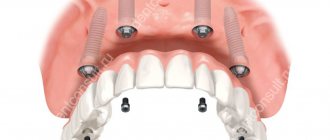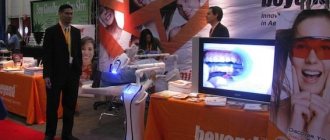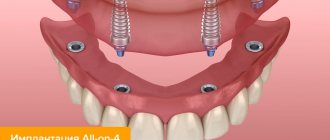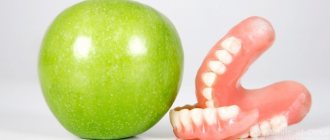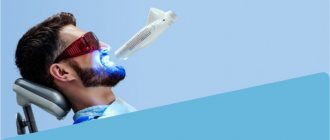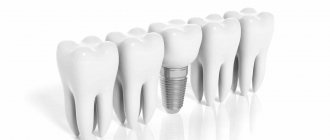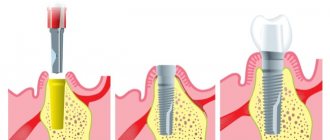The all on 4 method is implantation in the complete absence of teeth in the jaw, when a fixed bridge prosthesis is fixed to only 4 titanium supports. Prosthetics are performed no later than 72 hours after the implantation surgery, which allows patients to restore their teeth in record time.
The all on 4 technique is based on the unique properties of titanium. The metal is capable of merging with human bone tissue and forming a single, strong structure. The healing process is called osseointegration.
Nobel-Biocare, after further improvements to the titanium surface, achieved a uniquely rapid fusion of titanium and jaw bone tissue and in 1998 announced the all-on-4 protocol - “All on 4 implants”.
All-on-4: the essence of the protocol
The patient has 4 dental titanium implants surgically implanted into the bone tissue of the toothless jaw. Based on the casts, a permanent prosthesis is prepared, which is installed almost immediately. The first artificial jaw is temporary. It is worn for 5-36 months - it all depends on the design and material of the prosthesis. Then the orthopedic product is replaced with a new one, which the patient wears for decades.
Price
The most important stage - surgical implantation (implantation of the implants themselves and the fastenings on them) will cost the patient approximately 200-250 thousand rubles. This will also include the price for a temporary prosthesis, which is installed immediately after the operation.
The cost of the last stage - installation of the prosthesis will largely depend on the type and material of the structure selected by the patient. The price can vary from 200 to 600 thousand rubles.
Implantation is a fairly expensive procedure. The cost of treatment is based not only on the price of materials.
Research, technology, the work of doctors, and training of specialists require considerable expenses. In addition, not every clinic can afford the equipment used during the examination and, directly, the operation.
Indications for the installation of Semados implants and clinical cases where the use of systems is not justified.
In this publication you will find reviews of Roott implants.
At this address https://www.vash-dentist.ru/implantatsiya/proizvoditeli/byudzhetnyimi-ards.html we offer a detailed description of the design of ARDS implants.
Implantation ol he 4: features of the technique
All on four - implantation with wide possibilities. Thanks to a simplified method of implantation and prosthetics, tens of thousands of patients were able to restore the natural functions of their teeth and a beautiful smile.
The all on 4 protocol is based on the use of only 4 dental implants. They are the basis of the system, its main advantage. But also the one-stage “all on 4” implantation method is:
- computer planning
— an implant surgeon evaluates bone tissue density based on CT and 3D modeling results, selects optimal points for implantation without harming nearby anatomically important structures;
- inclined installation of 2 lateral implants
— titanium screws are implanted into the distal parts of the jaw at an angle of 30-45 degrees, which increases the area of contact between artificial roots and bone tissue and guarantees uniform load distribution;
- direct installation of a second pair of implants in the anterior jaw
— stabilization of the system, increasing its strength and convenience for patients;
- use of Multi-Unit abutments
— a special adapter system compensates for the difference between the installation angle of the titanium rod and the denture, which allows the artificial jaw to be placed anatomically correctly and comfortably for the patient.
Preparatory activities
Before the operation, no special preparation is required, however, if there is an infection at the site of the proposed prosthetics, which may somehow affect the quality of the operation, preliminary elimination of any inflammatory processes and removal of the remaining teeth are carried out.
Before installing implants, the doctor must examine the condition of the patient’s oral cavity and conduct cone-beam tomography. Based on its results, a computer model in 3D projection is developed.
This creates an exact digital copy of the patient’s jaw with its amount of bone tissue and taking into account all anatomical features.
The technology allows you to extremely accurately determine the location for installing artificial roots, obtain a complete three-dimensional picture of the oral cavity and develop a treatment method (create the most suitable model of the prosthesis).
Before surgery, the patient must undergo a standard examination for all surgical interventions.
Advantages of All-on-4 implantation
Benefits of choosing the all on 4 implantation method in comparison with the two-stage traditional protocol:
- small number of installed implants
— only 4 for fixing a full jaw prosthesis versus 6-10 implants using classical technology;
- instant installation of a full-fledged fixed prosthesis
— there is no need to wait for the implants to take root and endure inconvenient removable structures;
- minimum surgical steps
— when prosthetics are performed on 4 implants, the implants are placed without bone grafting, and the two-stage protocol often requires additional bone tissue augmentation;
- optimal survival rate
— for the all-on-4 protocol, implants with survival rates of more than 92% are used, and modern technologies and the professionalism of doctors increase this parameter to 98-99%;
- treatment speed
— an experienced implantologist needs no more than 2-3 hours to implant all four implants and preliminary remove the patient’s teeth if necessary.
Dental implantation using the all on 4 method is also actively compared with removable prosthetics. The advantages of the one-step protocol in this case are undeniable:
- Simple hygiene - fixed dentures are cleaned like regular teeth, there are no special conditions for storage, rinsing, or care.
- Convenience and comfort of use - artificial teeth “All on 4” have titanium roots and are tightly fixed in the mouth. The denture does not fall out, does not rub the gums, and does not interfere with speaking. The all on 4 system completely replaces regular teeth.
- Simple adaptation - adaptation lasts literally a few days and is associated with the restoration of the sensations of a full set of teeth in the oral cavity.
- The taste of dishes is preserved - the basis of removable systems distorts taste perception; a fixed all-on-four prosthesis is completely free of this drawback.
All on 4: disadvantages
The negative aspects of the “all-on-fo” protocol are very conditional:
- Contraindications
. There are limitations in any implantation option, but a thorough examination and a competent doctor help reduce the risks. In critical cases, the implantologist selects an alternative option for comfortable prosthetics.
- High demands on the professionalism of a doctor
. The all on 4 technique requires careful calculations, mastery of surgical techniques, and a competent assessment of any emerging situation. It’s easy to find a good implantologist who specializes in the “all-on-4” protocol based on doctor ratings.
- Loose bone tissue in a patient
. For the upper jaw, the problem is solved by selecting Nobel Zygoma zygomatic dental implants; for the lower jaw, by accurately calculating the time of all on 4 prosthetics.
What are the disadvantages of the technique?
Like any other surgical option, implantation using the All-on-4 system has its pros and cons. So, for example, it is not always possible to apply the protocol in cases where there are pronounced atrophic processes in the jaw bone and tissue inflammation. And inclined installation of standard-length models will not help here. Therefore, even with a moderate degree of bone resorption or periodontitis in the lower jaw, you need to choose an alternative method (more on alternatives a little later). In the upper jaw, specialists often decide to resort to the help of zygomatic structures - this is also the original “All on 4”, only modified. Or to increase the number of implants in order to ensure the reliability of the “implants + prostheses” system in the long term.
As experts note, as for the disadvantages of the technology, they mainly come down to the acute shortage in Russia of qualified personnel capable of carrying out such operations. For our country, the concept is still quite new, specialists are slowly mastering it, and today not many surgeons use immediate loading protocols in practice. To begin performing such operations, a specialist must have an excellent understanding of many areas of dentistry, master 3D visualization computer programs and, of course, undergo additional training in working with implant systems of the stated brands - directly from Nobel.
Another disadvantage concerns the breadth of distribution of this technology. Yes, this seems like a paradox, but here is the explanation. This is the most popular immediate loading implantation method and has a long history. This is why doctors use All-on-4 most often. But there are situations when this method is not very suitable for the patient, for example, if bone atrophy is severe. But the doctor does not know other protocols (for example, basal implantation) and cannot offer alternatives. He carries out this treatment, but after a while the whole system collapses and the patient remains dissatisfied. Of course, this doesn’t happen all the time, but incidents do happen.
Often, to carry out the procedure using the technology described above, restoration of bone tissue volumes is required, but in this case the plastic surgery is carried out simultaneously with the main surgical stage. To do this, the space around the implant is filled with synthetic material. If you plan to use zygomatic systems, then the requirements for the condition of the bone tissue will be significantly lower, especially since the concept allows you to fix 2 or even all 4 zygomatic models.
Prosthetics using the all on 4 system: who is it suitable for?
Photos of teeth “all on 4 implants” can be seen in different patients. This indicates the versatility of the technique and its wide popularity. The concept solves many dental and aesthetic problems of patients - radically, once and for all. All-on-4 can only be performed if there is a sufficient amount of jaw bone tissue. If there is severe atrophy or bone deficiency, the doctor will suggest alternative options.
All on 4 dental implantation technology is indicated if:
- completely edentulous
- all teeth are missing on one or even both jaws;
- partial edentia
— many teeth in the upper or lower jaw are missing, and the remaining ones must be removed due to mobility or disease;
- intolerance to removable dentures
- discomfort, gag reflex, allergic reaction to artificial teeth materials;
- contraindications to bone grafting
— bone augmentation is not possible for medical reasons.
Also, the all on 4 concept attracts patients who choose an economical and reliable implantation option for themselves. In this case, the issue is resolved directly with the implant surgeon. The doctor assesses the condition of problem teeth, conducts diagnostics, and decides on the possibility of implanting four titanium pins to install a fixed prosthesis.
All on 4 implants, if there are accompanying indications, are suitable for almost all patients who do not smoke, do not have serious diagnoses or dysfunctions of the endocrine and cardiovascular systems and monitor their oral health. If all this is present, the “all on four” protocol will be allowed for use.
Prices and reviews for all-on-4 dentures are very attractive. And more and more patients are interested in the all on 4 technique, seeking to restore a full set of teeth before truly serious problems arise with the gums and bone tissue.
Alternative Treatment Options
As alternative options for smile restoration, only one-stage treatment protocols should be considered, offering a quick solution to the problem without additional costs for bone grafting, at least in most cases.
So, among other immediate loading techniques, it makes sense to highlight the following concepts:
- Pro Arch (Straumann): we have already mentioned this technology above. It differs from All-on-4 in that it involves the use of Straumann implants, including shortened models for cases of more severe atrophy,
- All-on-3 or Trefoil (Nobel Biocare): a solution exclusively for the lower dentition, which can become a full-fledged alternative to All-on-4 if there is obvious atrophy of the lateral areas of the lower jaw, and installation of structures at an angle is not possible . The three implants are secured in a straight position in the anterior region, after which a prosthetic device with a stabilizing bar is placed on them. For this protocol, it is important that there is sufficient bone tissue in the frontal area,
- All-on-6: indicated for cases of more pronounced moderate resorption and involves the implantation of not one, but two implants on the sides, some or all of which can be zygomatic. As in previous cases, the prosthetic device can be fixed immediately or within a week after the procedure,
- Basal Complex: Basal implantation is considered the best solution for advanced cases of acute bone resorption, which can develop in parallel with periodontitis, periodontal disease or even osteoporosis. It is planned to use up to 14 implants per row, as well as the implantation of special design models. They penetrate into the denser layers of the jawbone, and their special coating helps to subside the signs of inflammation,
- zygomatic implantation: this is rather not a separate technique, but an addition to one-stage protocols, including All-on-4. By replacing 2 or even all 4 standard-sized implants with elongated zygomatic implants, you can achieve ideal primary stability. Of course, this will significantly increase the cost of treatment, but at the same time it will eliminate any risks of displacement or loss of implants due to lack or poor condition of bone tissue.
As mentioned above, dental implantation allows you to solve a complex of important issues at once, from restoring aesthetics to stopping the resorption of the jaw bone. At the same time, neither a bridge structure nor the highest quality removable prosthesis can provide the latter. With the advent of one-stage technologies, it has become possible for a wider range of patients to restore a beautiful and fully functional smile, and such dynamics in the development of modern dentistry cannot but rejoice.
According to the official website of the company nobelbiocare.com.
[ii] Agliardi E.L., Pozzi A., Stappert C.F., Benzi R., Romeo D., Gherlone E. Immediate fixed rehabilitation of the edentulous maxilla: a prospective clinical and radiological study after 3 years of loading, 2014.
Author: Chorny S.V. (Thank you for your help in writing the article and the information provided)
Single-stage implantation all on four: stages of prosthetics
Dental implants can be inserted in Moscow on a turnkey basis at different prices. In most cases, the cost is influenced by the volume of work performed, the type of dental implants, the experience and demand of the doctor. Dental clinics offer ready-made packages of services, which may differ significantly from each other. In order not to make a mistake and subsequently pay extra for important examinations and manipulations, the patient must know the stages of the “all on four” protocol.
All on 4 prosthesis: photos and features of ceramic composite
Usually there are only three main steps of all on 4 implantation:
- Preparatory.
- Surgical.
- Orthopedic.
In fact, the correct all-on-fo implantation protocol consists of six steps:
- Preparation, diagnostics.
- Implantation.
- Installation of an adaptive fixed prosthesis.
- Rehabilitation after surgery.
- Hygienic stage.
- Replacing a temporary denture with a permanent one.
Prices and promotions for dental implantation in Moscow directly depend on what stages of all on 4 the dental clinic takes into account, so it is worth considering the treatment in as much detail as possible.
Preparation for all-on-4 implantation surgery
The preparatory stage begins with diagnosis. Without an examination, no doctor will recommend implantation or select an implant manufacturer.
Examinations are necessary to exclude contraindications and plan treatment. Usual appointments for the patient:
- OPTG
— panoramic photo;
- CT
— 3D model, computed tomography result;
- standard set of analyzes - UAC
,
OAM
,
blood biochemistry.
If necessary or if there are certain diagnoses, the implantologist will refer the patient to a specialist for permission, an ECG and additional examinations. The decision is made individually according to the collected medical history.
In the photographs, the doctor will look at the volume and structure of the bone tissue of the jaws. This will be followed by computer planning, calculation of implantation points, and in some cases, production of a surgical template.
Simultaneously with building a treatment strategy, the doctor assesses the risks and gives prognoses for all-on-4 implantation. The result directly depends on the volume of preserved bone tissue - the more, the better. Experienced doctors know that ideal implant healing is guaranteed if:
- width of the alveolar ridge of the jaw - from 5 mm;
- the height of the bone tissue at the implantation point is 10 mm.
If the tests are good, the doctor agrees with the patient on the date of the operation and sends him to take impressions of the teeth, which will later serve as the basis for the manufacture of a denture.
All on 4 surgical protocol
The implementation of this stage depends on two points - the anesthesia chosen by the patient and the presence of teeth in the jaw.
Implantation is an unpleasant but fairly painless procedure, so it is usually performed under local anesthesia. However, the patient can choose to have all-on-4 implanted under sedation or anesthesia—in a state of drug-induced sleep. Artificial sleep makes the treatment unnoticeable and quick, eliminating anxiety and nervousness. Treatment during sleep is recommended for patients with dental phobia or other indications. The rest tolerate the procedure well under local anesthesia.
The presence of teeth in the jaw obliges the doctor to remove the remaining units before implantation. Then the surgeon immediately proceeds to installing artificial roots, implanting them at pre-planned points at precise angles.
Prices and reviews of all on 4 technology often lead to patients having both jaws restored at once. This can be done at one time, but the duration of the operation increases slightly. The effectiveness of such treatment is much higher than sequential implantation, since upon completion of all stages the patient becomes the owner of a full bite - two jaws with beautiful, even teeth.
Installation of a temporary adaptive prosthesis
While the surgical stage is underway or after it, a temporary adaptive fixed prosthesis is made for the patient in a dental laboratory. There are many requirements placed on him, as he must:
- completely replace the patient’s teeth until a permanent structure is installed;
- ensure normal, but not excessive load on implants and bone tissue - for rapid engraftment of artificial titanium roots;
- be comfortable, aesthetic, functional.
Temporary teeth are made of acrylic plastic with or without a metal frame. The presence of a beam determines the cost of the orthopedic structure, its durability and reliability. The metal base also affects the timing of fixation of the prosthesis on dental implants - immediately or after a few days.
The difference between the products is obvious:
Temporary denture without frame
- It is given to the patient directly on the day of all-on-4 implantation surgery.
- The operating life of the system is moderate - up to six months with mandatory replacement with a permanent option.
- The main advantage of the model is the price.
- The main disadvantages are fragility, high risk of breakage.
- The frameless option is not suitable for patients with bruxism or increased tone of the masticatory muscles.
Adaptive dental frame prosthesis
- Fixation on implants is performed 2-3 days after surgery, since dental technicians take longer to produce this orthopedic product.
- The metal frame guarantees the durability of artificial teeth - up to 2-3 years of trouble-free wearing.
- Advantages: durability, reliability, removal of all dietary restrictions.
- The disadvantage is the price.
Postoperative stage: recovery, recommendations
The all-on-4 surgical stage is almost always successful, but even an ideal operation requires follow-up monitoring by a doctor.
Patients are recommended:
- come for examination 1-2 times over the next 10 days - assess the condition of the gums, remove sutures, check the quality of healing;
- Gradually load the implants - eat moderately hard foods, slowly increase the chewing load.
Also, after implantation according to the all-on-4 protocol, the patient is required to follow the mandatory postoperative instructions:
- gentle brushing of teeth - using dental floss and mouthwash;
- calm rhythm of life - rest for the first 3-5 days after implantation;
- giving up smoking and alcohol - otherwise there may be difficulties with the implantation and general well-being.
Professional hygiene of an adaptive prosthesis
This stage is required for all temporary frame prostheses with a long wearing period. Its essence is professional cleaning and polishing of orthopedic structures in dentistry every six months. To do this, the doctor unscrews the 4 screws that secure the product to the implants, removes the denture and puts it in order. Then he fixes the artificial teeth back onto the implants.
Maintenance of the temporary structure by many clinics is included in the cost of turnkey all-on-4 implantation, but sometimes this is a separately paid procedure. To avoid incidents and unnecessary expenses, it is worth clarifying this point in advance.
Permanent prosthetics with all-on-fo implantation
After the implants have healed and the service life of the adaptive prosthesis has expired, the design is replaced with a permanent product. The patient himself chooses what exactly he will wear - based on material, price, aesthetics.
All-on-4 implantation is always the installation of an artificial jaw on 10-12 teeth, which is enough to ensure a beautiful smile and complete restoration of chewing functions. Larger structures for 12-14 teeth require 6 dental implants to be firmly fixed using the all-on-6 protocol.
Maintenance and care of the prosthesis –
Permanent dentures All-on-4 require a very careful attitude. If you previously had a regular removable denture and cleaning it from plaque and food debris was quite simple, now your time spent on hygiene will immediately increase several times. Unfortunately, this comes at a price for the opportunity to have completely permanent dentures. The biggest difficulty is cleaning the underside of the denture.
A fixed denture does not “lie” on the gums, and between the gum and the lower surface of the denture there will be a rinsing space - where food debris will certainly fall. And, accordingly, with insufficient hygiene, plaque and tartar will be deposited on the lower surface of the denture. To prevent this, it will be necessary to regularly use an oral irrigator, as well as use special super-flosses. In addition, regular cleaning of the denture with a soft toothbrush will be required.
Professional denture maintenance – approximately once every 6 months you will have to visit the dental clinic for a professional cleaning session of the denture (for patients with poor hygiene – once every 3 months). To do this, the screws that secure the bridge to the implants are unscrewed, and the prosthesis is removed from the mouth. The lower surface of the prosthesis is professionally cleaned and polished, and then the prosthesis is again fixed to the implants using screws.
An important point is that the quality of hygiene of the lower surface of the prosthesis will depend not only on your efforts. When making a denture, a dental technician may make mistakes that may not allow the patient to clean the lower surface of the denture at all. Normally, the lower surface of the prosthesis should have a convex shape, but very often we see that the lower surface of the prosthesis is given a concave shape (Fig. 24-25) - it becomes impossible to clean such a surface with floss.
Therefore, patients with a concave shape of the lower surface of the prosthesis always have a large amount of tartar on the prosthesis, always have bad breath, as well as inflammation around the implants, which over time can lead to failure of all implants. But let's see what else you need. Patients with titanium-polymer dentures will have to replace artificial teeth in the denture approximately once every 7 years. The fact is that teeth made of acrylic plastic or ceramic composite gradually wear out (this happens especially strongly in the chewing areas).
Wearing of the chewing teeth will lead to a decrease in the height of the bite in the chewing sections and, accordingly, to an increase in the chewing load on the front teeth (which sooner or later will not withstand the load and will break).
Implants for 4: what the prosthesis looks like - materials
In the photo, the dentures on 4 implants look different. Some are natural, like real teeth, others are simpler. Main materials used in prosthetics:
- metal ceramics;
- zirconium dioxide;
- ceramic composite.
What are the global differences between artificial jaws made of different materials - pros and cons, characteristics.
Metal ceramics for all-on-4 prosthetics
Metal-ceramics is familiar to everyone who has ever thought about inserting a tooth on a turnkey basis.
This is the most inexpensive and aesthetic material in orthopedic dentistry. It is chosen for single prosthetics with crowns and for the manufacture of a full-fledged artificial jaw. Advantages of metal ceramics for all-on-4 prosthesis:
- Excellent physical and mechanical properties.
Cobalt chromium alloy is used as a metal component. It is characterized by high resistance to deformation, strength, and reliability. - Quite a long service life
- dentures made of metal ceramics last up to 10 years. - Affordable cost
- in comparison with zirconium crowns, the cost of the orthopedic stage will be 1.5-2 times lower.
Metal-ceramics also have disadvantages:
- risk of developing allergic or galvanic reactions;
- slightly unnatural appearance, poor aesthetics;
- If repairs are necessary, the entire prosthesis must be removed for restoration in the laboratory.
Zirconium metal-free permanent all on 4 design
Metal-free orthopedic structures are indistinguishable from real teeth.
They not only reliably imitate crowns and enamel, but also form an ideal gum contour for “all-on-4” prosthetics. Advantages of zirconium products:
- Aesthetics and believability
. No one will be able to distinguish artificial zirconium teeth from real ones. - Mechanical strength
. Higher than that of metal-ceramic prostheses, which guarantees the reliability and integrity of the system when worn. - Biocompatibility with human tissues
. The material does not cause allergic reactions or gum irritation. Due to the absence of metal in the crowns, the risk of galvanization is eliminated. - Durability of wearing
. Zirconium dioxide is inert to food dyes and odors, does not deform or collapse, and lasts for decades without repair or replacement.
Disadvantages of the all-on-4 zirconia prosthesis:
- High price.
All on 4 prosthesis: photos and features of ceramic composite
Ceramic-composite dentures are used quite often for all-on-4 implantation.
The reasons are simple:
- Ideal aesthetics of real teeth
. Layer-by-layer application of polymer during the manufacture of a prosthesis ensures the natural color of the enamel and natural light transmission. - Resistant to food coloring
. There is no need for even the slightest restrictions after installing teeth using the “all on 4” protocol. - Strength, reliability
. Ceramic composite has a low level of wear. - Convenient, quick repair without removing dentures
. Any chip can be easily restored using ceramic composite material.
Flaws:
- The high price of a titanium-based prosthesis - especially if premium segment implants are chosen for all-on-4.
- Careful daily care - good oral hygiene using a irrigator to eliminate the risk of plaque forming from inside the crowns.
Indications
Cover dentures can be complete or partial, depending on the type of edentia (absolute/fragmental), the dentist establishes a specific model:
- the presence of single standing organs or their elements. When the bone is thinned up to 50% of the root length, spherical metal attachments are used, with atrophy of 50% - telescopic crowns, involution of more than 50% is an indication for magnetic fixators;
- unfavorable prognosis for the use of removable restorations with sharp involution of the alveolar processes, pronounced gag reflex, xerostomia;
- increased periodontal abrasion in the working area.
Contraindications are: diabetes mellitus, blood and heart pathologies, dysfunction of the endocrine system, diseases of the central nervous system, poor oral hygiene, the presence of impassable canals, inflammatory changes in the root tissues of molars that are not subject to therapy.
All on 4 or all on 6: what are the differences
The all-on-four protocol is recommended for patients with complete or partial edentia. In this case, some atrophy of bone tissue is acceptable - weak or moderate. If there is not enough bone material to stabilize the implants, then the doctor will consider a similar protocol with an increased number of implanted artificial roots - all-on-6.
This is an improved technique that involves the installation of 6 dental implants. The standard scheme is the implantation of implants in the tooth position 6-4-2|2-4-6. This guarantees uniform load on the bone, high primary stability of the system, and strength of fixation. It also allows the use of dentures with an increased number of crowns.
When restoring the upper jaw, doctors often use extended zygomatic implants. This helps to bypass anatomically dangerous areas and ignore atrophied bone tissue.
Possibilities of prosthetics
The “All on 4” technique allows you to install a denture with minimal costs (time, money), and at the same time restore full chewing function. This is the best option if you do not want to have a removable structure in your mouth.
Possibilities of the technique:
- Prosthetics regardless of age;
- Strong stabilization;
- Safety;
- Long service life;
- Correct load while chewing food;
- Possibility of changing prostheses;
- Speed – the operation is carried out within a day.
How much does it cost to install a dental implant in Moscow on a turnkey basis: full price of the service
You can get teeth placed on implants in Moscow at different prices. The promotional price starts from 140 thousand rubles for one jaw and includes all basic services. The minimum price is focused on the use of budget OSSTEM or Implantium implants with survival rates of 92-95%.
Maximum success is guaranteed by premium brands - Straumann and Nobel Biocare, but the price using implants from these manufacturers increases by 2-2.5 times.
Regular turnkey package:
- free consultation;
- surgical stage for installation of 4 implants;
- orthopedic stage - installation of a standard denture.
All other services must be negotiated additionally - as part of the offered package or at an additional cost.
Stages
- Preparation . The patient undergoes clinical and radiological examination. The implantologist selects a treatment protocol and plans the operation using computer modeling.
- Implantation. The surgical intervention, during which 4 implants are installed in the jaw, takes up to 3 hours. It is performed under local anesthesia, sedation or general anesthesia.
- Temporary prosthetics . The patient is fitted with an adaptive prosthesis immediately after implantation or within 72 hours.
- Permanent prosthetics . After a minimum of 4 months, the adaptation prosthesis is replaced with a permanent one.
All on 4 implantation: what’s the catch with the low price
When figuring out how much it costs to insert a dental implant in Moscow, many patients pay attention to unrealistically low prices. What is the catch with cheap services and what you need to pay attention to when choosing all on 4 implantation in metropolitan clinics:
- Savings on prosthesis and implantation components
.
A dental implant is usually a prefabricated structure that directly includes a titanium screw and an abutment adapter. The product is loaded with a denture on top. Saving on abutments and prosthetics reduces the cost of “all-on-four” implantation, but poses risks later. Potential problems include numerous corrections, broken abutments, frequent repairs of dentures, allergies to the material, staining of crowns.
- Inexpensive implants
.
Ratings of dental implants introduce patients to numerous series of different price ranges. But the all-on-4 protocol was created exclusively for Nobel Biocare. Today, series of all premium brands, products of the South Korean company OSSTEM, and the Dentium Implantium line are adapted to the “all on 4” concept. All other implants are a risk for the patient.
- Partial provision of services
.
To increase the attractiveness of all-on-4 implantation, many clinics indicate the price not “turnkey”, but for one stage - usually for dental surgery. The patient pays for everything else independently. The risk of such a situation can be reduced by clarifying the specific services in the package and carefully studying the contract, which specifies the fixed final price and its components.
- Inexperienced doctors
.
To reduce prices and attract patients, a number of clinics invite young implantologists. The patient saves, and the doctors learn to do quality work. Participation in such a “project” is a lottery with rare winnings.
Having decided to take care of your own health, you should not save on all-on-4 implantation. The consequences and risks are much more serious than they initially seem.
How dental implantation is performed: description of implant installation technology
The surgical stage of dental restoration according to the “All-on-4” concept, i.e. installation of the implantological system is carried out in accordance with a pre-developed plan. As part of this protocol, two-piece models from Nobel Biocare are implanted, onto which multi-unit abutments are then fixed for subsequent screw-fastening of the prosthesis.
The operation is carried out using special surgical templates - these are special stencils made of elastic material, which are created according to the individual parameters of each individual patient. They allow you to place implants with maximum accuracy in accordance with the points selected using the program.
This technique uses the patchwork method, that is, by peeling off a section of the gum and forming a bed for the structure using a bur or other surgical instruments. However, with the start of using templates, it was possible to significantly reduce the traumatic nature of the procedure. Implants are literally screwed into the bone tissue through holes in elastic stencils. In this case, small punctures are first made in the gums, which exactly match the diameter of the implanted structures. Which approach to use depends on the skill of the doctor and the approach of the clinic as a whole. But both options are possible; it is up to the implant surgeons to decide.
Alternatives to all-on-4 implantation
The most popular alternative to all-on-4 implantation is the all-on-6 protocol. A larger number of implants, stability and also a fairly favorable price. But it happens that both concepts are not suitable for patients - for financial or other reasons.
Then the dental clinic offers alternative solutions for the complete restoration of the dentofacial line:
- Fixed dental bridge
. For strong fixation, it requires the presence of supporting healthy teeth and can sufficiently replace missing units externally and functionally.
- Removable dental prosthesis
. It has virtually no contraindications and is very inexpensive. But even one made from the most modern materials differs from all-on-4 implantation in increased discomfort in wearing and maintenance. Increases the risk of rapid bone tissue atrophy.
- Prosthesis on 6-10 implants
. The doctor uses a classic two-stage implantation protocol. The patient needs to be prepared for significant expenses and long-term wearing of a removable denture. The permanent structure will be installed only after the artificial titanium roots have completely engrafted.
- Basal implantation
. A special feature of the technique is the use of implants that reach the basal bone during installation. The basal bone is dense, not prone to atrophy, and supports implants well. The method is recommended for smokers, as well as for patients with diabetes.
All-on-4 implantation guarantees a full mouth of teeth in the shortest possible time. A safe, comfortable method of treating adentia and other dental problems. You can select a clinic for a profitable operation with a promotion and an experienced implant surgeon in the corresponding ratings on the 1dentist website.
Possible complications
It must be taken into account that after implantation, complications may develop, the most likely of which are:
- implant rejection – occurs due to biological incompatibility of living tissues with the metal of the structure;
- peri-implantitis is a purulent inflammatory process provoked by infection;
- pain – headaches, as well as localized in the area of implants, temporomandibular joint;
- swelling of the soft tissues, minor bleeding is the norm in the early postoperative period, but if these phenomena are protracted, they are a sign of pathology;
- an unpleasant odor is usually a consequence of improper care of an artificial jaw with 4 implants.
To exclude post-implantation complications, three conditions must be met. First, choose high-quality implants with prostheses from reliable well-known manufacturers. Secondly, contact dental clinics where highly qualified implant surgeons work, like in Yulisty. Thirdly, take proper care of the orthopedic structure - clean it regularly, use an irrigator, and come for professional cleaning on time.
When urgent help is needed
Normally, pain and swelling of the gums disappear a few days after the procedure. Headaches or discomfort in the temporomandibular joint may occur due to atrophy of the masticatory muscles after a long period of absence of teeth. As a rule, they also pass quickly after restoration of muscle function. However, in some cases, urgent medical intervention is necessary:
- prolonged bleeding - can be caused by damage to blood vessels during surgery;
- increasing swelling and pain, increased temperature - signs of an inflammatory process;
- discharge of fluid from the nose is a consequence of damage during implantation of the maxillary sinuses;
- numbness of the jaw is the result of cutting or pinching of the conductive nerves during the installation of implants.
Features of the classic protocol
Classical implantation is a two-stage process: in the first stage, implants are implanted, in the second, a prosthesis is installed. Between stages, a certain amount of time passes, necessary for the fusion of titanium roots with the jawbone. Implantation of titanium roots occurs using the patchwork method - the doctor cuts the gum, folds back the mucous flap, forms a hole in the bone into which the root-like implant is screwed and sutured the wound.
After complete osseointegration (after 3-6 months), the gum is cut again, and a gum former is fixed to the implant to achieve the desired aesthetics of the gingival margin. After 10-14 days, the former is replaced with an abutment, onto which a permanent prosthetic structure is attached. In case of bone atrophy, before installing a titanium root, it is necessary to do directed osteoplasty (on the lower jaw) or sinus lift (on the upper jaw).
Prices for installing overdentures
| Code no. | NAME OF PROCEDURES | Unit of measurement | Cost, rub. |
| 702 | Taking an impression with alginate mass | 1 500,00 | |
| 706 | Making a custom spoon | 4 500,00 | |
| 707 | Making a bite template | 3 000,00 | |
| 752 | Complete removable denture on a bar structure with attachments | 190 000,00 | |
| 757 | Complete removable monomer-free prosthesis “Quadrotti” | 60 000,00 | |
| 762 | Complete removable denture reinforced with mesh | 65 000,00 |
The final price tag for a service in our dental clinic starts from 12,000 rubles and consists of the number of prosthetic organs, the material of the system, and the method of forming the base. If a natural base is used, preliminary tissue preparation may be required: removal of high mucosal frenulums and cords, periodontal pockets, gingivotomy to lengthen the crown. When resting on dental implants, their number is taken into account - 6, 4 or 2. The more artificial support units are needed, the more expensive the product will be.
To find out the cost of an overdenture on implants, sign up for a consultation at Dr. Razumenko’s dentistry in Moscow. To do this, fill out the application form on the website or call.
* The prices indicated on the website are not a public offer. The exact cost of treatment can only be determined at an appointment with a doctor.
Prices for treatment in Moscow full price list
Share on social media networks:
Article Expert:
Kochetkova Varvara Alekseevna
Dentist-therapist. Graduated from the Peoples' Friendship University of Russia. Additional education - Federal State Budgetary Institution of Further Professional Education of the Central State Academy of Administration of the President of the Russian Federation.
Work experience: more than 5 years
